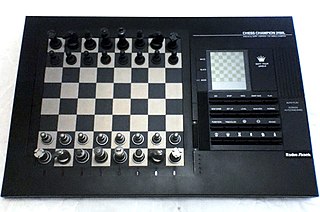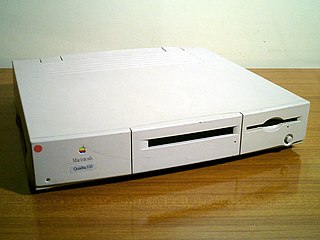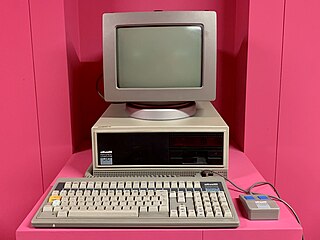Related Research Articles

The Tandy 1000 was the first in a series of IBM PC compatible home computers produced by the Tandy Corporation, sold through its Radio Shack and Radio Shack Computer Center stores. Introduced in 1984, the Tandy 1000 line was designed to offer affordable yet capable systems for home computing and education. Tandy-specific features, such as enhanced graphics, sound, and a built-in joystick port, made the computers particularly attractive for home use.

Computer chess includes both hardware and software capable of playing chess. Computer chess provides opportunities for players to practice even in the absence of human opponents, and also provides opportunities for analysis, entertainment and training. Computer chess applications that play at the level of a chess grandmaster or higher are available on hardware from supercomputers to smart phones. Standalone chess-playing machines are also available. Stockfish, Leela Chess Zero, GNU Chess, Fruit, and other free open source applications are available for various platforms.

The Amiga 2000 (A2000) is a personal computer released by Commodore in March 1987. It was introduced as a "big box" expandable variant of the Amiga 1000 but quickly redesigned to share most of its electronic components with the contemporary Amiga 500 for cost reduction. Expansion capabilities include two 3.5" drive bays and one 5.25" bay that could be used by a 5.25" floppy drive, a hard drive, or CD-ROM once they became available.

The Personal System/2 or PS/2 is IBM's second generation of personal computers. Released in 1987, it officially replaced the IBM PC, XT, AT, and PC Convertible in IBM's lineup. Many of the PS/2's innovations, such as the 16550 UART, 1440 KB 3.5-inch floppy disk format, 72-pin SIMMs, PS/2 port, and VGA video standard, went on to become standards in the broader PC market.

The C64 Direct-to-TV, called C64DTV for short, is a single-chip implementation of the Commodore 64 computer, contained in a joystick, with 30 built-in games. The design is similar to the Atari Classics 10-in-1 TV Game. The circuitry of the C64DTV was designed by Jeri Ellsworth, a computer chip designer who had previously designed the C-One.

The Atari Portfolio is an IBM PC-compatible palmtop PC, released by Atari Corporation in June 1989. It was the first palmtop computer compatible with the IBM PC ever released.

The Macintosh Quadra 950 is a personal computer designed, manufactured and sold by Apple Computer from March 1992 to October 1995. It replaced the Quadra 900 that was introduced several months earlier, increasing the CPU clock rate of its 68040 CPU from 25 MHz to 33 MHz, and improving the graphics support. The two computers were otherwise identical, including the price. With a Macintosh Processor Upgrade Card installed, this computer is known as the Power Macintosh 950.

The Compaq Portable II is the fourth product in the Compaq Portable series to be brought out by Compaq Computer Corporation. Released in 1986 at a price of US$3499, the Portable II much improved upon its predecessor, the Compaq 286, which had been Compaq's version of the PC AT in the original Compaq Portable chassis; Portable 286 came equipped with 6/8-MHz Intel 286 and a high-speed 20 MB hard drive, while the Portable II included an 8 MHz processor, and was lighter and smaller than the previous Compaq Portables. There were four models of the Compaq Portable II. The basic Model 1 shipped one 5.25" floppy drive and 256 KB of RAM. The Model 2 added a second 5.25" floppy drive and sold for $3599. The Model 3 shipped with a 10 MB hard disk in addition to one 5.25" floppy drive and 640 KB of RAM for $4799 at launch. The Model 4 would upgrade the Model 3 with a 20 MB hard drive and sold for $4999. There also may have been a 4.1 MB hard drive included at one point. The Compaq Portable II was significantly lighter than its predecessors, the Model 1 weighed just 23.6 pounds compared to the 30.5 pounds the Compaq Portable 286 weighed. Compaq only shipped the system with a small demo disk, MS-DOS 3.1 had to be purchased separately.

The Macintosh Quadra 605 is a personal computer designed, manufactured, and sold by Apple Computer from October 1993 to July 1996. The model names reflect a decision made at Apple in 1993 to follow an emerging industry trend of naming product families for their target customers – Quadra for business, LC for education, and Performa for home. Accordingly, the Performa 475 and 476 was sold in department stores and electronics stores such as Circuit City, whereas the Quadra was purchased through an authorized Apple reseller.

The IBM 3270 PC, is a personal computer developed by IBM and released in October 1983. Although its hardware is mostly identical to the IBM PC XT, the 3270 contains additional components that, in combination with software, can emulate the behavior of an IBM 3270 terminal. Therefore, it can be used both as a standalone computer, and as a terminal to a mainframe.

The Macintosh Quadra 610, originally sold as the Macintosh Centris 610, is a personal computer designed, manufactured and sold by Apple Computer from February 1993 to July 1994. The Centris 610 was introduced alongside the larger Centris 650 as the replacement for the Macintosh IIsi, and it was intended as the start of the new midrange Centris line of computers. Later in 1993, Apple decided to follow an emerging industry trend of naming product families for their target customers – Quadra for business, LC for education, and Performa for home – and folded the Centris 610 into the Quadra family.

The Leading Edge Model D is an IBM clone first released by Leading Edge Hardware in July 1985. It was initially priced at $1,495 and configured with dual 5.25" floppy drives, 256 KB of RAM, and a monochrome monitor. It was manufactured by South Korean conglomerate Daewoo and distributed by Canton, Massachusetts-based Leading Edge. Engineer Stephen Kahng spent about four months designing the Model D at a cost of $200,000. Kahng later became CEO of Macintosh clone maker Power Computing.

The Tandy Memorex Video Information System (VIS) is an interactive, multimedia CD-ROM player produced by the Tandy Corporation starting in 1992. It is similar in function to the Philips CD-i and Commodore CDTV systems. The VIS systems were sold only at Radio Shack, under the Memorex brand, both of which Tandy owned at the time.

The AT&T UNIX PC is a Unix desktop computer originally developed by Convergent Technologies, and marketed by AT&T Information Systems in the mid- to late-1980s. The system was codenamed "Safari 4" and is also known as the PC 7300, and often dubbed the "3B1". Despite the latter name, the system had little in common with AT&T's line of 3B series computers. The system was tailored for use as a productivity tool in office environments and as an electronic communication center.

The Power Macintosh 5500 is a personal computer designed, manufactured, and sold by Apple Computer from February 1997 to March 1998. Like the Power Macintosh 5260 and 5400 that preceded it, the 5500 is an all-in-one design, built around a PowerPC 603ev processor operating at 225, 250 or 275 megahertz (MHz).

A BBC Micro expansion unit, for the BBC Micro is one of a number of peripherals in a box with the same profile and styling as the main computer.
The Commodore PC compatible systems are a range of IBM PC compatible personal computers introduced in 1984 by home computer manufacturer Commodore Business Machines.

The Olivetti M24 is a computer that was sold by Olivetti in 1983 using the Intel 8086 CPU.
The ICL DRS was a range of departmental computers from International Computers Limited (ICL). Standing originally for Distributed Resource System, the full name was later dropped in favour of the abbreviation.

The Personal System/2 Model 30 and Personal System/2 Model 30 286 are IBM's entry-level desktop computers in their Personal System/2 (PS/2) family of personal computers. As opposed to higher-end entries in the PS/2 line which use Micro Channel bus architecture, the Model 30 features an Industry Standard Architecture bus, allowing it to use expansion cards from its direct predecessors, the PC/XT and the PC/AT. The original PS/2 Model 30, released in April 1987, is built upon the Intel 8086 microprocessor clocked at 8 MHz and features the 8-bit ISA bus; the Model 30 286, released in September 1988, features the Intel 80286 clocked at 10 MHz and includes the 16-bit ISA bus.
References
- Swedish Chess Computer Association (SSDF) - R30 entry
- Gideon on the Chessmachine
- Schachcomputer.info - The Wiki for chess computers (in German)